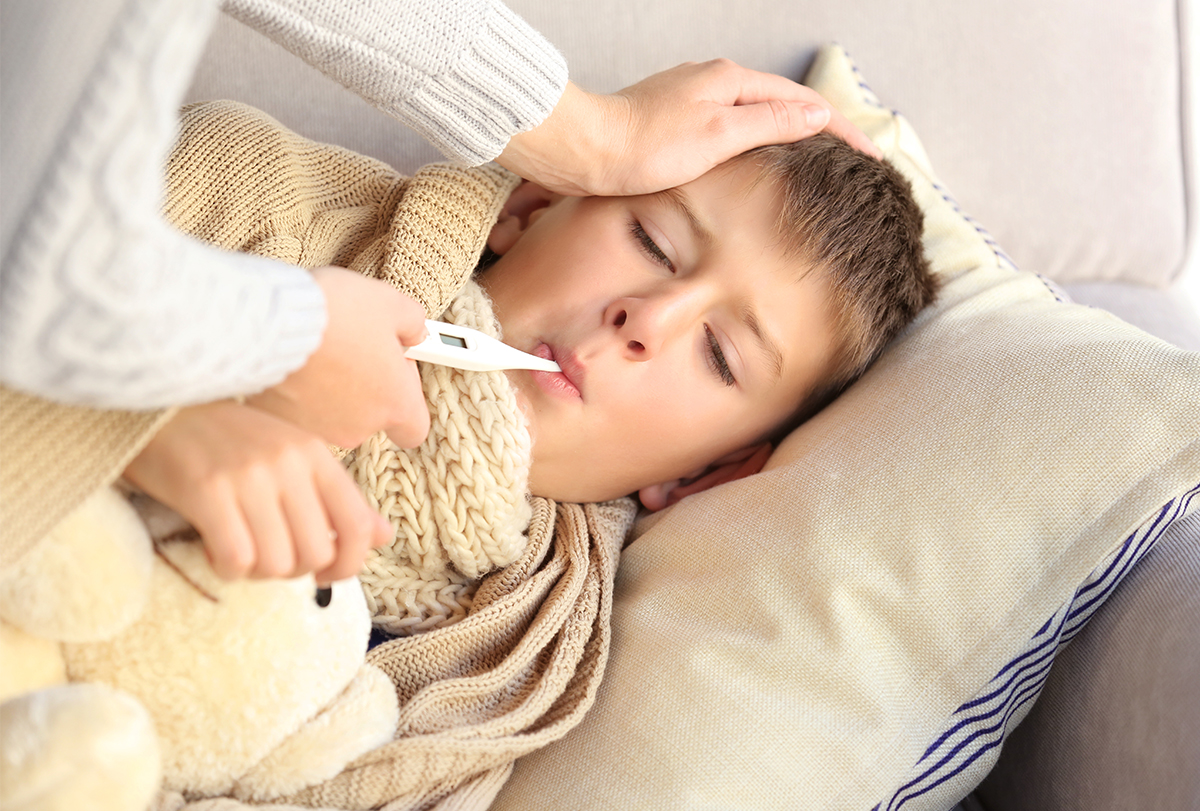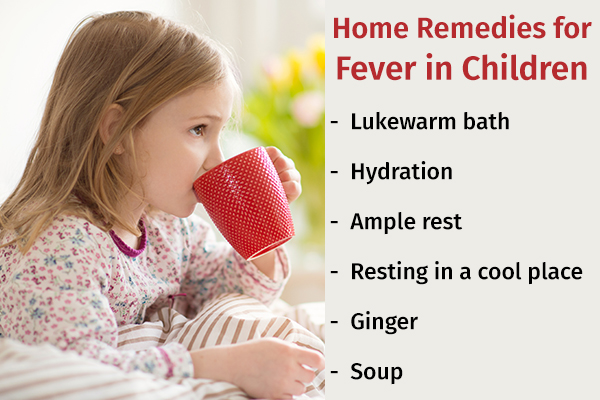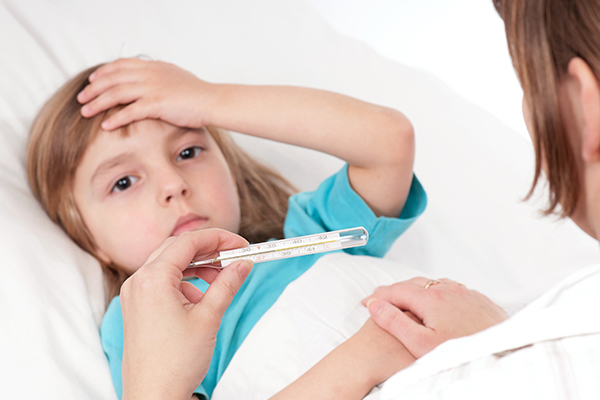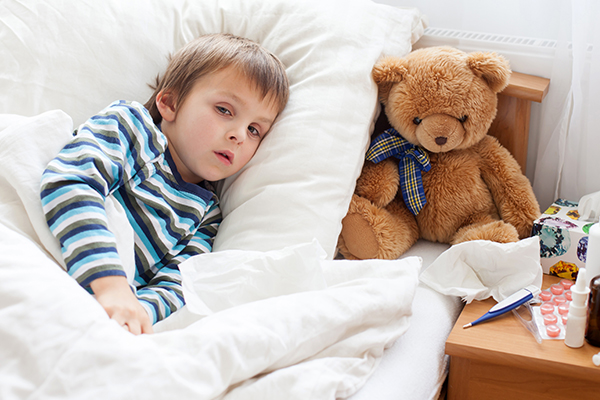In this article:
A fever is a rise in the body’s core temperature, primarily as a physiologic response. A normal body temperature in humans is 37°C (98.6°F) and may fluctuate by approximately 0.5°C throughout the day. Fever is defined as a core temperature of 38°C (100.4°F) or higher when taken rectally.

The elevations in temperature can be secondary to a potential pathological process (bacteria, viruses, fungi, drugs, or toxins), causing a release of immunological mediators, which further act on the thermoregulatory center in the hypothalamus. This results in a rise in body temperature.
Fever in a child is a very frequent cause of visits to the emergency department or outpatient setting, accounting for 15%–25% of medical consultations. (1)(2) The child’s temperature can be measured at home by parents or caregivers in the ear (tympanic membrane) or forehead (temporal artery) area or clinically by healthcare professionals in the rectal, oral, and axillary regions. (2)
Home Remedies for Fever in Children

The following remedies can be done at home to comfort children with a fever:
1. Lukewarm bath
A batch with lukewarm water may be helpful although temporarily.
Note that cold baths or tepid sponging is not recommended. External cooling may cause peripheral vasoconstriction, further causing shivering and distress to the child and potentially increasing core body temperature. (7)
2. Hydration
Hydration is vital when your child has a fever to prevent dehydration. Water or popsicles can be given to the child. Avoid caffeinated beverages as they can increase urination.
3. Ample rest
Ample rest is important when your child has a fever. It is also recommended for a child to stay home from school or any physical activities until the fever has resolved for at least 24 hours.
4. Resting in a cool place
Resting in a cool place may be beneficial. Avoid cooling fans that may cause the child to shiver. (7)
5. Ginger
Ginger possesses antioxidative and anti-inflammatory effects that may be beneficial for the underlying etiologies causing the fever. (8)
6. Soup
Alongside water and popsicles, soup can contribute to hydration.
Normal Body Temperature in Children
Variations in core body temperatures are observed throughout the day. Temperature readings of 37°C (98.6°F) to 37.2°C (98.9°F) in the morning and 37.7°C (99.9°F) throughout the day are considered normal.
In infants, the core temperature during the night may be as low as 36°C and can elevate to 37.8°C throughout the day, particularly after feeding.
Major Causes of Fever in Children
Nearly 55%–60% of children presenting with a fever in an inpatient or outpatient setting will have a distinguished source of infection on examination.
Common infectious causes include:
- Acute otitis media
- Viral illnesses such as influenza, varicella, roseola, croup, and bronchiolitis, pneumonia
Other causes considered in children aged 3–36 months include:
- Meningitis
- Sepsis
- Pneumonia
- Malignancy
- Cellulitis
Other less common etiologies of fever include:
- Noninfectious causes
- Immune-mediated causes
- Inflammatory disorders
- Kawasaki disease
- Neoplasms/malignancy
Recurrent fevers in children are largely due to respiratory viral infections, such as colds and flu, which may cause up to 11 respiratory infections annually and are the leading cause of recurrent fever.
When an etiology for fever is unidentified on examination, it is termed “fever without source” (FWS). The primary cause of FWS may be an underlying urinary tract infection or a possible self-resolving viral illness.
Children receiving immunization may also develop fever 24–48 hours later. (3)
Symptoms of Fever in Children

A temperature of 38°C (100.4°F) or higher, when taken rectally, is defined as a fever. Additional manifestations include:
- Pale or flushed appearance
- Sweating
- Chills
- Headache
- Drooling
- Muscle aches
- Decreased to no appetite
- Irritability
- Dehydration
- Fatigue
- Generalized weakness
- Swollen neck glands
Children between the ages of 6 months and 5 years may experience febrile seizures. Although frightening for parents, the majority of children who experience febrile seizures possess no lasting effects.
General Treatment Plan for Fever in Children
Symptomatic management with antipyretics, such as acetaminophen or ibuprofen, can be beneficial and effective in reducing fever in children. Antipyretics do not treat the underlying cause of the fever but may help alleviate the elevated body temperature. (4)
Long-term use of ibuprofen is not advised as it can cause irritation of the gastric lining. (5) Treatment with aspirin should be avoided as it can cause Reye syndrome in children. (6)
Risk Factors Associated With Fever in Children

As discussed previously, children between the ages of 5 months and 6 years may experience febrile seizures, which are characterized by involuntary jerking and stiffening of the muscles.
Following the seizure, the child may experience a state of confusion (also known as the postictal state), which may resolve within a couple of minutes. This can happen as a one-time occurrence in some children and more often in others. (9)
A medical evaluation is advised to rule out any underlying cause of the convulsions other than a febrile seizure. Although frightening for parents, febrile seizures have no lasting effects in the majority of children.
When to See a Doctor
Medical help from a healthcare professional should be sought when the child has any of the following signs and symptoms:
- A rectal temperature of 100.4°F (38°C) in infants 3 months old or younger
- Pale, ashen, mottled, or blue appearance
- Unresponsiveness to verbal command
- Difficulty trying to stay awake or conscious
- Extreme irritation/discomfort
- Continuous weak or high-pitched crying
- Hunching forward and drooling
- Decreased urine output despite hydration
- Increased heart rate and respiratory rate
- A non-blanching rash
- Seizures/convulsions
- Bulging fontanelle and neck stiffness
- Bad headache
Extra Precautions for Children With a Fever

It is important to note any additional changes or progression of symptoms when a child has a fever. Most fevers are self-limited and the temperature goes back to normal within a few days with or without any additional symptomatic management.
If any of the signs and symptoms mentioned previously are present and you are unsure about your child’s well-being, it is recommended to seek medical advice.
Final Word
General complications from a fever depend on the underlying etiology. A fever can be a result of a self-resolving viral illness or something more complicated such as meningitis. Although home remedies can help in reducing fever in children, it is vital to keep an eye out for red flags, such as the ones mentioned above, and seek medical attention when necessary.
- Was this article helpful?
- YES, THANKS!NOT REALLY


